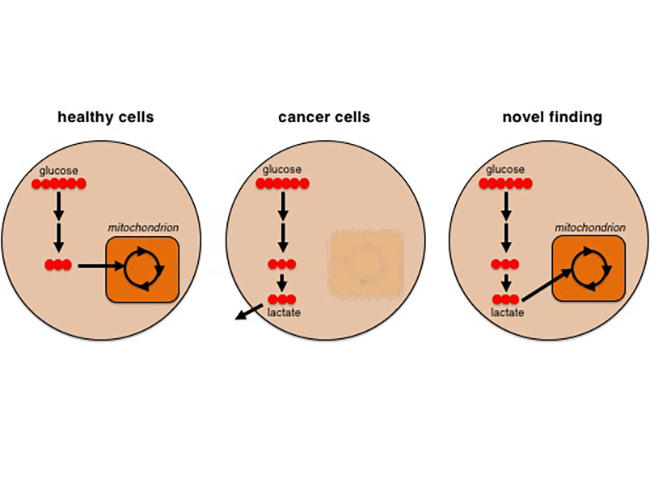Metabolomics Study Reveals another Energy Source for Cancer Cells
, by NCI Staff
Researchers have discovered another way that cancer cells may produce the energy they need to survive and grow.
Using new metabolomics technologies, the researchers found that cancer cells can use the compound lactate to fuel biochemical reactions and to generate other compounds needed for cell growth, such as lipids to build new cellular membranes. Metabolomics is the science of measuring small molecules, such as glucose, amino acids, and cholesterol, within a biological sample.
The finding was unexpected because lactate, a partially digested form of glucose, is thought to be secreted by cells as a waste product.
“Our study shows that—at some times in some cancer cells—lactate can be used productively to make other nutrients the cell needs,” said Gary J. Patti, Ph.D., of Washington University in St. Louis, who led the research.
By tracking the chemical transformations of lactate within cancer cells, the researchers found that, rather than being expelled from cells, lactate was being taken up by mitochondria, which are considered the energy factories of cells. “It’s possible that the productive use of lactate is occurring in the mitochondria,” said Dr. Patti.
The study results appeared in Nature Chemical Biology on September 12.
Differences in Metabolism
As healthy cells become cancerous, their metabolism changes. Healthy cells produce energy by taking in and metabolizing glucose molecules during a two-phase process. The first phase occurs in the cytoplasm and does not rely upon oxygen; the second takes place in mitochondria and requires oxygen.
Mitochondria produce most of the energy that cells need to live. Only a small percentage of glucose’s energy can be extracted without oxygen (anaerobically)—that is, in the cytoplasm—whereas the vast majority is extracted in the mitochondria.
Cancer cells have been thought to largely forgo the mitochondrial phase of energy production. The observation that cancer cells, which are growing and dividing rapidly, would rely only on the less-efficient phase of glucose metabolism has long been a puzzle to researchers.
“We have wondered why a cancer cell would be so wasteful,” said Dr. Patti. Cancer cells have been thought to compensate for the lost energy by “revving up” the first phase and breaking down glucose rapidly, as a result secreting relatively large quantities of lactate, he noted.
Lactate is produced when glucose is metabolized rapidly in the cytoplasm. The new work suggests that the lactate produced by the revved-up anaerobic metabolism can be further metabolized following transport into the mitochondria rather than being excreted, as happens in noncancerous cells, noted Michael Espey, Ph.D., of NCI’s Division of Cancer Biology, who was not involved in the study.
The new findings suggest that “in cancer cells, mitochondria can use lactate in a manner that is distinct from how it is used in the cytoplasm,” added Dr. Espey.
An Unexpected Finding
Dr. Patti’s team made its discovery while testing a way to tag molecules in cancer cells and use a technology known as untargeted metabolomics to track their movements. For the test, the investigators selected lactate, assuming that it would not be as widely distributed in cells as other compounds.
The results were surprising—nearly every lipid in the cell ended up being tagged as a metabolic product of lactate. “We saw thousands of labeled signals,” said coauthor Amanda Ying-Jr Chen, Ph.D., who is a postdoctoral fellow in Dr. Patti’s lab. “It was very unexpected and exciting.”
To confirm the findings, the researchers conducted additional experiments with individual mitochondria in cancer cells. These experiments showed that lactate can be transported into mitochondria and used to generate nutrients for the cell.
The results have raised many new questions. “We still need to figure out when and how lactate is getting into mitochondria,” Dr. Patti said.
A broader question, Dr. Espey added, is: What mechanisms govern how cells use their resources to meet their needs? “We don’t yet know how the master allocation of resources for each cell is determined,” he said.
Lactate and Lung Tumors
“This study provides an example of the tremendous flexibility of cancer cells in terms of how they utilize fuel,” said Ralph DeBerardinis, M.D., Ph.D., who directs the Genetic and Metabolic Disease Program at the Children’s Medical Center Research Institute at UT Southwestern and who was not involved in the research.
He and his colleagues published a recent study showing that lactate is an energy source for human lung tumors in mice. “Our findings are consistent with the new study,” said Dr. DeBerardinis. “But the new research goes quite a bit further than our study by providing a mechanism by which cancer cells utilize lactate.”
The new study shows that mitochondria can contain one of the enzymes associated with lactate metabolism, Dr. DeBerardinis continued. In his study of lung tumors, Dr. DeBerardinis had assumed that lactate would be metabolized in the cytoplasm rather than the mitochondria.
“If lactate is a waste product, then it should not be in the mitochondria,” he added. “But if lactate is to be used as a fuel, as the new study suggests, then it makes sense that it would be in the mitochondria.”
Dr. Patti’s study was conducted in cultured cells, and it will be important to see whether the process takes place in tumors in the body, Dr. DeBerardinis noted. “Our study of lung tumors in mice suggests that it probably does.”
Future studies will address the generality of the new findings for other types of cancer, Dr. Espey predicted.
“These studies can also determine the degree to which mitochondrial lactate metabolism is part of the cancer cell’s toolkit to withstand stresses for their survival,” he added.
